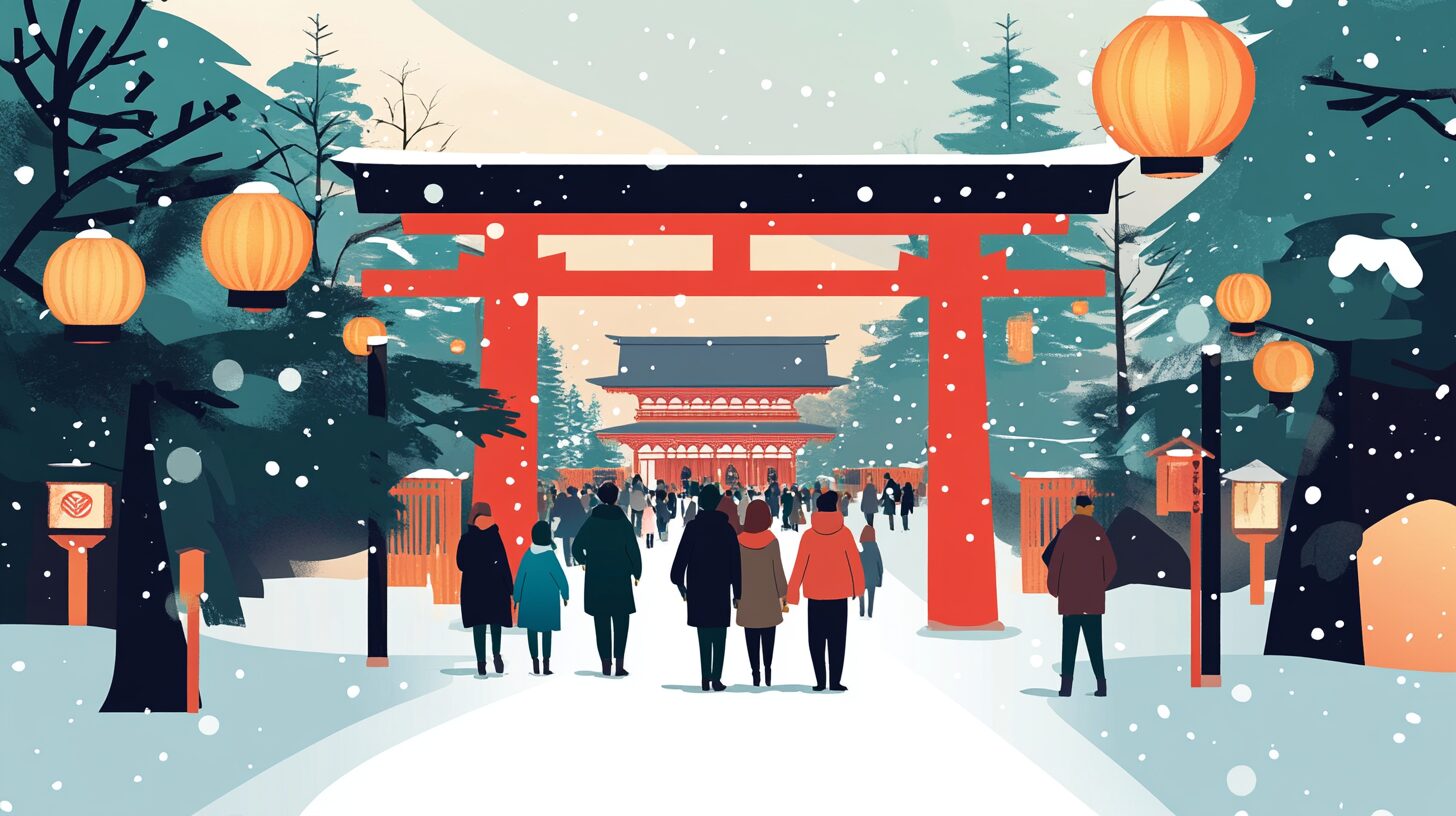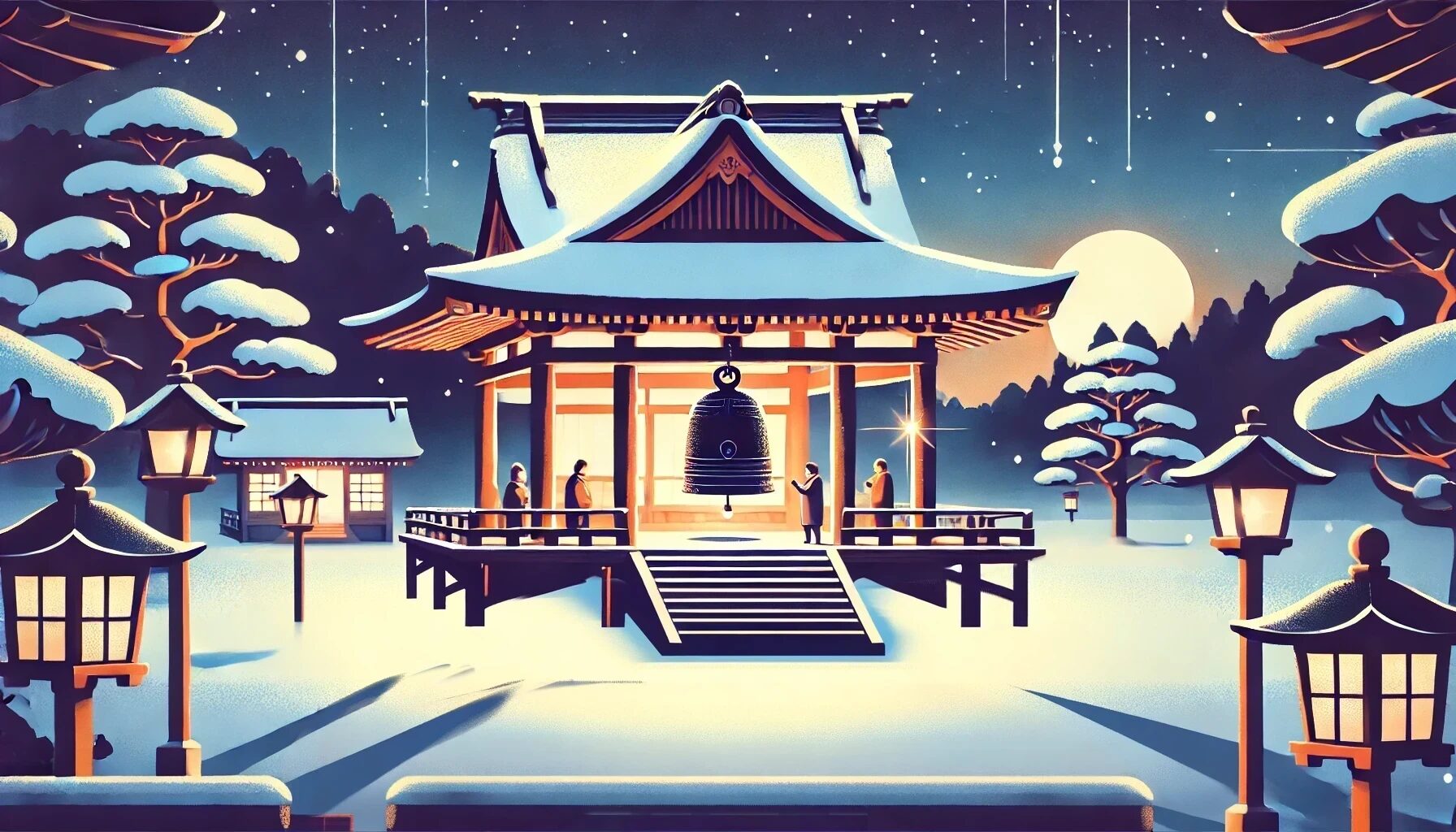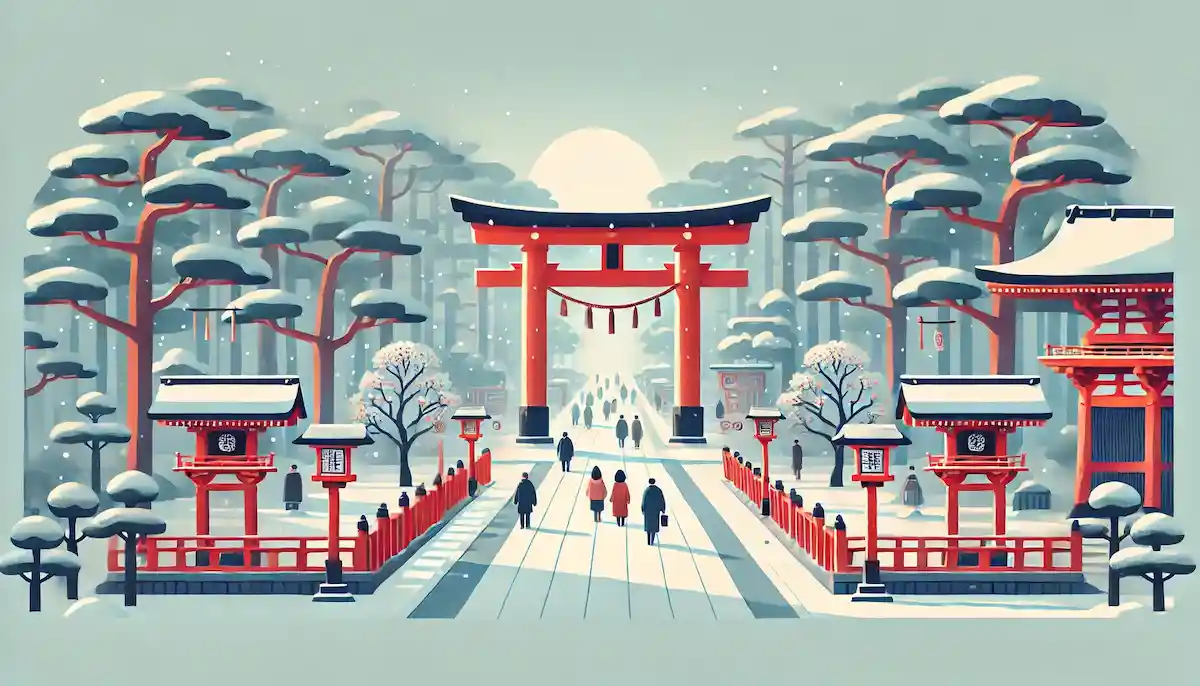初詣を英語で説明・紹介するための基本情報と、英会話に役立つ表現をシンプルでわかりやすい英語で紹介します。
英会話ダイアローグ・概要・10の質問を通して、初詣に関する英語表現を学びます。
英語
英会話ダイアローグを読む前に知っておくと良い前提知識と情報です。
- 初詣とは
- 新年に初めて神社や寺院を訪れる行事で、新年の健康や幸運を祈る
- 1月1日から3日に行うのが一般的
- 初詣の主要なポイント
- 参道の真ん中は神様の通り道なので、端を歩く
- 鳥居の前で軽くお辞儀をして敬意を表す
- 手水舎での清め方:
- 左手→右手→口の順に水を使い、最後に柄杓を清める
- 神社では「二礼二拍手一礼」を行い、静かに祈る
- 賽銭箱にお金を入れるが、5円玉は「ご縁」として縁起が良いとされている
- 初詣で楽しめるアクティビティ
- おみくじは、運勢を占うくじ、悪い結果は神社に結び、良い結果は持ち帰る
- お守りは、健康、恋愛、学業など目的別の守り札、毎年新しいものに交換するのが一般的
- 絵馬は、願いごとを書いて奉納する木の板、受験や恋愛成就の願いが多い
- どんど焼きは、古いお守りや絵馬を燃やして浄化する儀式
2人が初詣について話しています。
参道の歩き方、手水舎での作法、参拝方法、お賽銭の意味や金額の選び方、おみくじやお守り、絵馬などを話題にしています。
会話 / dialogue

Hey Key, I heard you’re going to Hatsumode this New Year. What’s that like?

Oh, it’s a really special tradition here in Japan. It’s the first visit to a shrine or temple at the start of the year. We go to pray for health, success, and happiness in the new year.

Sounds fascinating! So, do you go on January 1st?

Usually, yes. The first three days of the year are the most common, but some people visit later in January if they’re busy.

What do you do when you get to the shrine?

Well, the first thing is to approach the shrine respectfully. On the sando—that’s the path leading to the shrine—you should avoid walking in the center.

Why is that?

The center of the path is for the gods. We walk on the sides to show respect.

Got it. Anything else?

Before entering through the torii gate, you should bow lightly. It’s a way to show respect as you step into the sacred area.

That’s interesting. Then what happens?

Next, you purify yourself at the water basin, called temizuya. You wash your hands and rinse your mouth to cleanse yourself.

Is there a specific way to do it?

Yes! First, use the ladle to pour water over your left hand, then your right hand. After that, pour some water into your left hand to rinse your mouth. Finally, clean the ladle by letting water flow over the handle.

Got it. What’s next?

After purification, you head to the main shrine to pray. If it’s a shrine, you follow the “two bows, two claps, one bow” method: bow twice, clap your hands twice, make your prayer silently, and bow once more.

And temples?

At temples, you just bow and pray quietly with your hands together. No clapping.

Oh, I’ve seen people throwing coins into a box before praying. What’s that about?

That’s osaisen, a monetary offering to the gods. You toss the coin into the offering box before you pray.

Is there a specific amount I should give?

Not really. Any amount is fine, but a lot of people choose a 5-yen coin.

Why 5 yen?

In Japanese, 5 yen is pronounced go-en, which sounds like “good luck” or “a good connection.” So it’s considered lucky.

That’s clever. So I just toss it in and start praying?

Yes, but toss it gently! If there’s a bell, you ring it—it’s said to purify you and call the gods’ attention.

Interesting. Are there other activities?

Yes! Many people draw omikuji, which are fortune slips. You shake a box, draw a slip, and see your luck for the year—things like health, love, and career.

What if the fortune is bad?

If it’s bad, you can tie it to a special rack at the shrine to leave the bad luck behind. If it’s good, you can keep it with you for the year.

That’s cool. What about those wooden plaques I’ve seen in pictures?

Oh, those are ema. You write your wishes on them—like passing an exam or finding love—and hang them at the shrine.

Can you take them home?

Not usually. They’re left at the shrine so the gods can receive your wishes.

What about those small pouches I’ve seen people carry?

Those are omamori, protective charms. Each one is for a specific purpose, like health, love, or safety in travel.

Can you reuse them each year?

It’s better to replace them yearly. You can bring the old ones back to the shrine for a special burning ceremony called Dondo-yaki.

This sounds like such a meaningful tradition. Can I join you this year?

Of course! Just dress warmly—it’s cold—and be ready for crowds. It’ll be a great experience for you!

Thanks, Key. I’m looking forward to it!
概要 / Overview
「初詣」について、理解を深めるための「英語での概要」です。
初詣

What is Hatsumode?
Hatsumode is the first visit to a shrine or temple in Japan at the beginning of the new year. It is a tradition where people pray for good health, happiness, and success in the coming year. Families, friends, and couples often go together to participate in this important cultural event. Hatsumode usually takes place between January 1st and 3rd, but some people visit later in January if they are busy. This custom is a way to start the year with a positive and respectful mindset.
The Purpose of Hatsumode
The main purpose of Hatsumode is to thank the gods for the past year and to pray for blessings in the new one. People also ask for specific wishes, such as success in exams, health for their families, or good fortune in relationships. This tradition has its roots in ancient customs like “Toshigomori,” where people stayed at a shrine overnight to pray for safety and happiness.
Steps to Follow at a Shrine
When you visit a shrine for Hatsumode, there are a few important steps to follow. First, as you walk along the sando (the path leading to the shrine), avoid the center because it is believed to be the gods’ path. Before entering the shrine through the torii gate, bow lightly to show respect. At the temizuya (water basin), purify yourself by washing your hands and rinsing your mouth. Then, approach the main shrine, toss a coin into the offering box, and pray using the “two bows, two claps, one bow” method.
Activities During Hatsumode
Hatsumode offers some special activities. One popular activity is drawing omikuji, which are fortune slips. They predict your luck for the year. If you get a bad fortune, you can tie it to a special rack at the shrine to leave the bad luck behind. Another activity is buying omamori, protective charms for health, love, or success. You can also write your wishes on ema, wooden plaques, and hang them at the shrine.
A Meaningful Tradition
Hatsumode is a unique and meaningful way to celebrate the start of the year in Japan. It combines respect for tradition, hopes for the future, and gratitude for the past. Whether you are visiting a shrine for the first time or continuing a family custom, Hatsumode offers a chance to connect with Japanese culture and set positive intentions for the year ahead.
10の質問 / 10 questions
「初詣」について、理解を深めるための「英語での10の質問」です。
1: What is Hatsumode?
Hatsumode is the first visit to a shrine or temple in Japan at the start of the new year. People go to pray for health, happiness, and good fortune for the year ahead.
2: When does Hatsumode usually take place?
Hatsumode is typically done between January 1st and 3rd, but some people visit later in January if they are busy.
3: What do people do at a shrine during Hatsumode?
People purify themselves at the water basin, offer a coin, and pray using the “two bows, two claps, one bow” ritual. They may also draw omikuji or buy omamori.
4: What is the purpose of Hatsumode?
The purpose is to thank the gods for the past year and pray for blessings, such as good health, success, and happiness, in the new year.
5: What is omikuji, and why do people draw it?
Omikuji is a fortune slip that tells your luck for the year. People draw it to see their fortune in areas like health, love, and career.
6: What do you do if you get a bad fortune in omikuji?
If you get a bad fortune, you can tie it to a special rack at the shrine to leave the bad luck behind.
7: What are omamori, and what are they used for?
Omamori are protective charms for health, love, safety, or other purposes. They are believed to bring good luck and protection.
8: What is the proper way to walk on the sando (shrine path)?
On the sando, you should avoid walking in the center because it is considered the gods’ path. Instead, walk on the sides to show respect.
9: What do you do before entering through the torii gate?
Before entering through the torii gate, you should bow lightly to show respect as you enter the sacred area.
10: Why do people use 5-yen coins for osaisen (monetary offering)?
Many people use 5-yen coins because the Japanese word for 5 yen (go-en) sounds like “good fortune” or “a good connection,” making it a lucky choice.
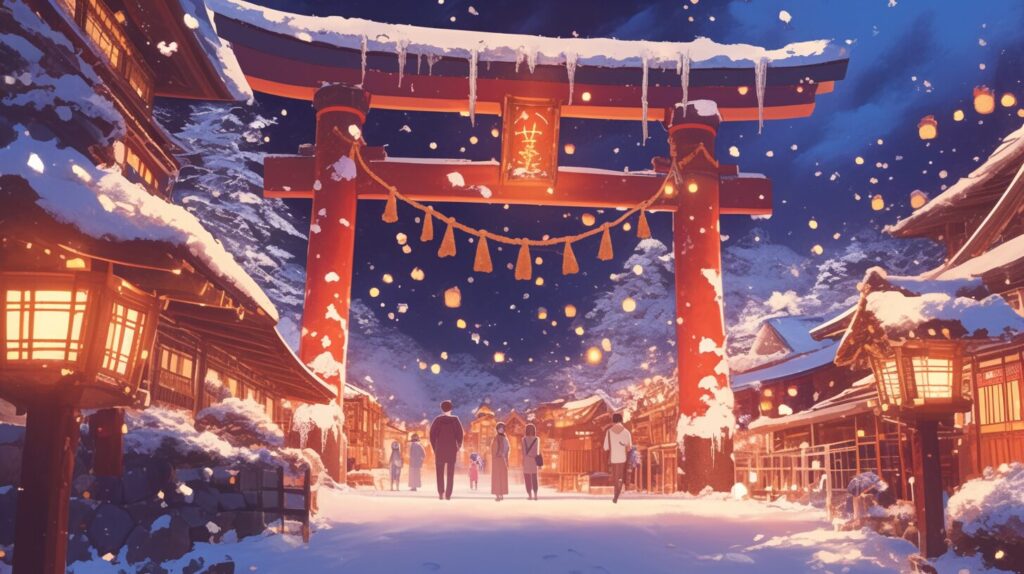
和訳付
会話 / dialogue

Hey Key, I heard you’re going to Hatsumode this New Year. What’s that like?
キー、新年に初詣に行くって聞いたけど、どんな感じなの?

Oh, it’s a really special tradition here in Japan. It’s the first visit to a shrine or temple at the start of the year. We go to pray for health, success, and happiness in the new year.
日本ではすごく特別な伝統だよ。年明けに神社やお寺を初めて訪れて、健康、成功、そして幸せを祈るんだ。

Sounds fascinating! So, do you go on January 1st?
面白そう!それって1月1日に行くの?

Usually, yes. The first three days of the year are the most common, but some people visit later in January if they’re busy.
普通はそうだね。年の最初の3日間が一番多いけど、忙しい人は1月の後半に行くこともあるよ。

What do you do when you get to the shrine?
神社に着いたら何をするの?

Well, the first thing is to approach the shrine respectfully. On the sando—that’s the path leading to the shrine—you should avoid walking in the center.
まずは神社に敬意を持って近づくことかな。参道って呼ばれる神社に続く道の真ん中は歩かないようにするんだ。

Why is that?
どうして?

The center of the path is for the gods. We walk on the sides to show respect.
真ん中は神様の通り道だからだよ。敬意を示すために端を歩くんだ。

Got it. Anything else?
了解。他には?

Before entering through the torii gate, you should bow lightly. It’s a way to show respect as you step into the sacred area.
鳥居をくぐる前に軽くお辞儀をするのも大事だよ。神聖な場所に入る前の敬意の表現だね。

That’s interesting. Then what happens?
面白いね。それで次は?

Next, you purify yourself at the water basin, called temizuya. You wash your hands and rinse your mouth to cleanse yourself.
次は手水舎っていう水の場所で体を清めるよ。手を洗って口をすすいで浄化するんだ。

Is there a specific way to do it?
特別なやり方があるの?

Yes! First, use the ladle to pour water over your left hand, then your right hand. After that, pour some water into your left hand to rinse your mouth. Finally, clean the ladle by letting water flow over the handle.
あるよ!最初に柄杓で左手、次に右手に水をかける。それから左手に少し水を受けて口をすすぐんだ。最後に柄杓を立てて持ち手を清めるよ。

Got it. What’s next?
分かった。それで次は?

After purification, you head to the main shrine to pray. If it’s a shrine, you follow the “two bows, two claps, one bow” method: bow twice, clap your hands twice, make your prayer silently, and bow once more.
浄めた後は本殿に行ってお祈りするんだ。神社の場合は「二礼二拍手一礼」だよ。2回お辞儀して、2回手をたたいて、静かに祈りを捧げて、最後に1回お辞儀するの。

And temples?
お寺は?

At temples, you just bow and pray quietly with your hands together. No clapping.
お寺では静かに合掌して祈るだけだよ。手をたたくことはないんだ。

Oh, I’ve seen people throwing coins into a box before praying. What’s that about?
ああ、祈る前に箱にお金を投げ入れるのを見たことがあるけど、あれは何?

That’s osaisen, a monetary offering to the gods. You toss the coin into the offering box before you pray.
それは「お賽銭」だよ。祈る前に賽銭箱にお金を入れるんだ。

Is there a specific amount I should give?
入れる金額は決まっているの?

Not really. Any amount is fine, but a lot of people choose a 5-yen coin.
特に決まりはないよ。でも、多くの人が5円玉を選ぶかな。

Why 5 yen?
どうして5円なの?

In Japanese, 5 yen is pronounced go-en, which sounds like “good luck” or “a good connection.” So it’s considered lucky.
日本語では5円を「ご縁」って読むんだけど、それが「良い縁」って意味に通じるから縁起がいいんだ。

That’s clever. So I just toss it in and start praying?
なるほど。じゃあ入れてすぐ祈ればいいの?

Yes, but toss it gently! If there’s a bell, you ring it—it’s said to purify you and call the gods’ attention.
そうだけど、優しく入れてね!もし鈴があれば鳴らして、浄めと神様への呼びかけをするんだ。

Interesting. Are there other activities?
興味深いね。他にも何かある?

Yes! Many people draw omikuji, which are fortune slips. You shake a box, draw a slip, and see your luck for the year—things like health, love, and career.
あるよ!多くの人が「おみくじ」を引くんだ。箱を振ってくじを引いて、その年の運勢を見るの。健康、恋愛、仕事とかね。

What if the fortune is bad?
運勢が悪かったらどうするの?

If it’s bad, you can tie it to a special rack at the shrine to leave the bad luck behind. If it’s good, you can keep it with you for the year.
悪かったら神社の特別な場所に結んで厄を落とすんだ。良かったら1年持っておいてもいいよ。

That’s cool. What about those wooden plaques I’ve seen in pictures?
写真で見た木の板みたいなものは何?

Oh, those are ema. You write your wishes on them—like passing an exam or finding love—and hang them at the shrine.
あれは「絵馬」だよ。試験合格とか恋愛成就とかの願いを書いて神社に掛けるんだ。

Can you take them home?
持ち帰ることはできるの?

Not usually. They’re left at the shrine so the gods can receive your wishes.
普通はしないね。神様に願いを届けるために神社に残しておくんだ。

What about those small pouches I’ve seen people carry?
人が持ち歩いている小さな袋は何?

Those are omamori, protective charms. Each one is for a specific purpose, like health, love, or safety in travel.
あれは「お守り」。健康、恋愛、旅行の安全など、それぞれ特定の目的があるんだ。

Can you reuse them each year?
毎年使い回せるの?

It’s better to replace them yearly. You can bring the old ones back to the shrine for a special burning ceremony called Dondo-yaki.
毎年新しいものに交換した方がいいね。古いものは「どんど焼き」っていう特別な儀式で燃やしてもらえるよ。

This sounds like such a meaningful tradition. Can I join you this year?
とても意義深い伝統だね。今年一緒に行ってもいい?

Of course! Just dress warmly—it’s cold—and be ready for crowds. It’ll be a great experience for you!
もちろん!暖かくしてきてね、寒いから。それに混雑も覚悟しておいて。でもきっと素晴らしい体験になるよ!

Thanks, Key. I’m looking forward to it!
ありがとう、キー。楽しみにしてるよ!
概要 / Overview
初詣

What is Hatsumode?
Hatsumode is the first visit to a shrine or temple in Japan at the beginning of the new year. It is a tradition where people pray for good health, happiness, and success in the coming year. Families, friends, and couples often go together to participate in this important cultural event. Hatsumode usually takes place between January 1st and 3rd, but some people visit later in January if they are busy. This custom is a way to start the year with a positive and respectful mindset.
初詣とは?
初詣は、新年に日本の神社やお寺を初めて訪れる行事です。人々は新年の健康、幸せ、成功を祈ります。家族や友人、恋人同士で一緒に参加することが多い、重要な文化的なイベントです。通常は1月1日から3日の間に行われますが、忙しい場合は1月中に訪れる人もいます。この習慣は、年の始まりを前向きで敬意を持った気持ちで迎えるためのものです。
The Purpose of Hatsumode
The main purpose of Hatsumode is to thank the gods for the past year and to pray for blessings in the new one. People also ask for specific wishes, such as success in exams, health for their families, or good fortune in relationships. This tradition has its roots in ancient customs like “Toshigomori,” where people stayed at a shrine overnight to pray for safety and happiness.
初詣の目的
初詣の主な目的は、前年の感謝を神様に伝え、新年の祝福を祈ることです。また、試験の成功や家族の健康、恋愛の良縁など、具体的な願いをする人も多いです。この伝統は、神社で一晩過ごして安全や幸福を祈った「年籠り」という古代の習慣に由来しています。
Steps to Follow at a Shrine
When you visit a shrine for Hatsumode, there are a few important steps to follow. First, as you walk along the sando (the path leading to the shrine), avoid the center because it is believed to be the gods’ path. Before entering the shrine through the torii gate, bow lightly to show respect. At the temizuya (water basin), purify yourself by washing your hands and rinsing your mouth. Then, approach the main shrine, toss a coin into the offering box, and pray using the “two bows, two claps, one bow” method.
神社での手順
初詣で神社を訪れる際には、守るべき重要な手順がいくつかあります。まず、参道(神社に続く道)では真ん中を歩かないようにしましょう。そこは神様の通り道と考えられています。鳥居をくぐる前に軽くお辞儀をして敬意を示します。手水舎では、手を洗い、口をすすいで体を清めます。その後、本殿に進み、賽銭箱にお金を入れて、「二礼二拍手一礼」の方法で祈りを捧げます。
Activities During Hatsumode
Hatsumode offers some special activities. One popular activity is drawing omikuji, which are fortune slips. They predict your luck for the year. If you get a bad fortune, you can tie it to a special rack at the shrine to leave the bad luck behind. Another activity is buying omamori, protective charms for health, love, or success. You can also write your wishes on ema, wooden plaques, and hang them at the shrine.
初詣でのアクティビティ
初詣では特別なアクティビティを楽しむことができます。人気のあるものの一つは「おみくじ」を引くことです。おみくじは、その年の運勢を占います。悪い運勢が出た場合は、神社の特別な場所に結び付けて厄を払うことができます。他には「お守り」を購入することもできます。お守りは健康や恋愛、成功を守るためのものです。また、「絵馬」という木の板に願い事を書いて神社に掛けることもできます。
A Meaningful Tradition
Hatsumode is a unique and meaningful way to celebrate the start of the year in Japan. It combines respect for tradition, hopes for the future, and gratitude for the past. Whether you are visiting a shrine for the first time or continuing a family custom, Hatsumode offers a chance to connect with Japanese culture and set positive intentions for the year ahead.
意義深い伝統
初詣は、日本で新年を祝うための独特で意義深い方法です。この行事は、伝統への敬意、未来への希望、そして過去への感謝を融合させたものです。初めて神社を訪れる人も、家族の習慣を続ける人も、初詣は日本文化に触れ、新しい年に前向きな目標を立てる機会を提供してくれます。
10の質問 / 10 questions
1: What is Hatsumode?
初詣とは何ですか?
Hatsumode is the first visit to a shrine or temple in Japan at the start of the new year. People go to pray for health, happiness, and good fortune for the year ahead.
初詣は新年に日本の神社やお寺を初めて訪れることです。人々は健康、幸福、そして一年の幸運を祈ります。
2: When does Hatsumode usually take place?
初詣は通常いつ行われますか?
Hatsumode is typically done between January 1st and 3rd, but some people visit later in January if they are busy.
初詣は通常、1月1日から3日の間に行われますが、忙しい場合は1月の後半に訪れる人もいます。
3: What do people do at a shrine during Hatsumode?
初詣で神社では何をしますか?
People purify themselves at the water basin, offer a coin, and pray using the “two bows, two claps, one bow” ritual. They may also draw omikuji or buy omamori.
手水舎で体を清め、お賽銭を捧げ、「二礼二拍手一礼」の作法で祈ります。また、おみくじを引いたりお守りを買ったりします。
4: What is the purpose of Hatsumode?
初詣の目的は何ですか?
The purpose is to thank the gods for the past year and pray for blessings, such as good health, success, and happiness, in the new year.
目的は、前年の感謝を神様に伝え、新年の健康、成功、幸せなどの祝福を祈ることです。
5: What is omikuji, and why do people draw it?
おみくじとは何ですか?また、なぜ人々はそれを引くのですか?
Omikuji is a fortune slip that tells your luck for the year. People draw it to see their fortune in areas like health, love, and career.
おみくじは一年の運勢を占うためのくじです。人々は健康、恋愛、仕事などの運勢を知るために引きます。
6: What do you do if you get a bad fortune in omikuji?
おみくじで悪い運勢が出たらどうしますか?
If you get a bad fortune, you can tie it to a special rack at the shrine to leave the bad luck behind.
悪い運勢が出た場合は、神社の特別な場所に結び付けて厄を落とします。
7: What are omamori, and what are they used for?
お守りとは何ですか?また、それは何に使われますか?
Omamori are protective charms for health, love, safety, or other purposes. They are believed to bring good luck and protection.
お守りは、健康、恋愛、安全などのための護符です。それは幸運や守護をもたらすと信じられています。
8: What is the proper way to walk on the sando (shrine path)?
参道を歩く正しい方法は何ですか?
On the sando, you should avoid walking in the center because it is considered the gods’ path. Instead, walk on the sides to show respect.
参道では、神様の通り道とされる中央を歩かず、端を歩いて敬意を示します。
9: What do you do before entering through the torii gate?
鳥居をくぐる前に何をしますか?
Before entering through the torii gate, you should bow lightly to show respect as you enter the sacred area.
鳥居をくぐる前に軽くお辞儀をして、神聖な場所に入る際の敬意を示します。
10: Why do people use 5-yen coins for osaisen (monetary offering)?
なぜ人々はお賽銭に5円玉を使うのですか?
Many people use 5-yen coins because the Japanese word for 5 yen (go-en) sounds like “good fortune” or “a good connection,” making it a lucky choice.
多くの人が5円玉を使うのは、5円の日本語「ご縁」が「良い縁」を意味する言葉に通じているため、縁起が良いとされているからです。
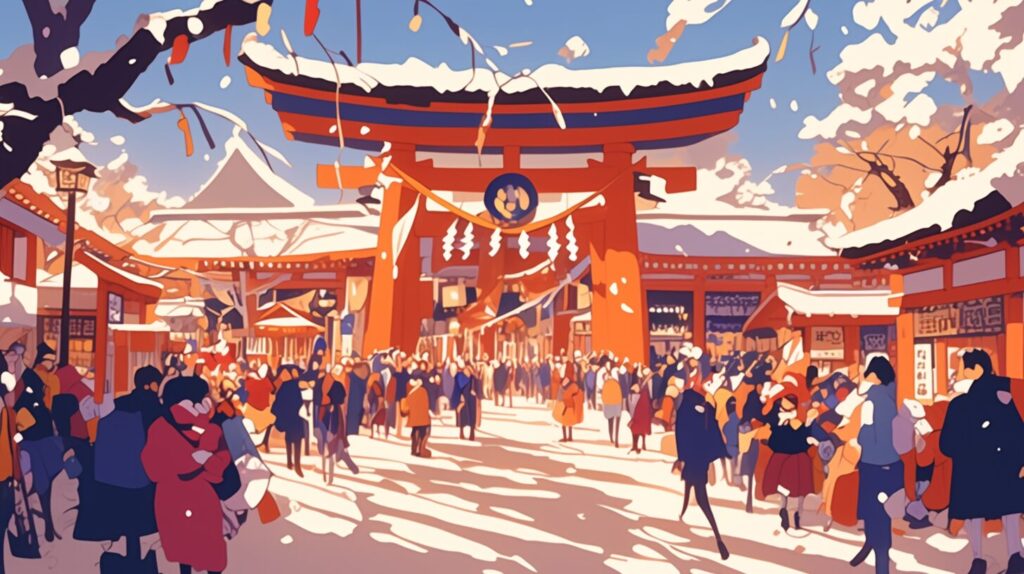
words & phrases
英会話ダイアローグと関連情報に出てきた単語・フレーズです(例文は各3つ)。

purify : 動詞
意味: 不純物を取り除く、浄化する。To remove impurities or make something clean or pure.
(初詣で、手水舎で心身を清める行為を指す)
例文:
- They used water to purify the temple grounds.
「彼らは神殿の敷地を清めるために水を使いました。」 - At the shrine, visitors purify their hands before praying.
「神社では、参拝者は祈る前に手を清めます。」 - This machine can purify the air in the room.
「この機械は部屋の空気を浄化することができます。」
cleanse : 動詞 /klenz/
意味: 清潔にする、洗浄する。To clean thoroughly or remove dirt or harmful substances.
(初詣の手水舎で体や心を清める行為を指す)
例文:
- The water was used to cleanse the visitors’ hands.
「その水は参拝者の手を清めるために使われました。」 - She felt the ritual could cleanse her spirit.
「彼女はその儀式が心を清めてくれると感じました。」 - The doctor advised her to cleanse the wound carefully.
「医者は傷口を注意深く清潔にするようにアドバイスしました。」
ladle : 名詞 /ˈleɪ.dl̩/
意味: 柄杓。液体をすくうための長い柄のある器具。A long-handled spoon used for serving or scooping liquids.
(手水舎で水をすくうための道具として登場)
例文:
- Use the ladle to scoop water and cleanse your hands.
「柄杓を使って水をすくい、手を清めてください。」 - The chef used a ladle to pour the soup into bowls.
「シェフは柄杓を使ってスープを器に注ぎました。」 - At the shrine, visitors each take a turn with the ladle.
「神社では参拝者が順番に柄杓を使います。」
prayer : 名詞 /preər/
意味: 祈り、祈祷。The act of communicating with a god or spirit, often in a formal setting.
(初詣で祈願する行為を指す)
例文:
- She said a quick prayer before entering the shrine.
「彼女は神社に入る前に短い祈りを捧げました。」 - His prayers were answered when he got the job.
「彼の祈りは叶い、仕事が決まりました。」 - The priest led the visitors in a formal prayer.
「神父は参拝者たちを率いて正式な祈りを捧げました。」
plaque : 名詞 /plæk/
意味: 板、名札、記念プレート。A flat piece of material with writing or decoration, often used for commemorative or decorative purposes.
(初詣で絵馬として使われる木の板を指す)
例文:
- Visitors write their wishes on a plaque and hang it at the shrine.
「参拝者は願いを板に書いて神社に掛けます。」 - The plaque on the wall honors the founder of the shrine.
「壁のプレートは神社の創設者を讃えています。」 - Each plaque has a different design depending on the shrine.
「それぞれの板は神社によって異なるデザインです。」
詳細情報 / Further Info
参拝の作法とルール
1. Understanding the Sando (Shrine Path)
The sando is the path that leads to the shrine. When you walk on this path, avoid the center, as it is believed to be the gods’ path. Instead, walk along the sides to show respect. This small gesture demonstrates your awareness of the sacred space and your consideration for the gods.
参道の理解
参道は神社へ続く道です。この道を歩く際は、中央を避けてください。中央は神様の通り道とされているためです。その代わり、道の端を歩くことで敬意を表します。この小さな行動が、神聖な場所への配慮と神様への敬意を示します。
2. Bowing at the Torii Gate
Before entering the shrine, you will pass through a torii gate. This gate marks the boundary between the everyday world and the sacred space of the shrine. Stop in front of the gate and bow lightly before entering. This action shows that you recognize the importance of the space you are about to enter.
鳥居での一礼
神社に入る前に、鳥居をくぐります。この鳥居は日常の世界と神聖な空間との境界を示します。鳥居の前で立ち止まり、軽く一礼してから中に入ります。この行動は、これから入る空間の重要性を認識していることを示します。
3. Cleansing at the Temizuya
Once inside, head to the temizuya, the water basin used for purification. Use the ladle provided to cleanse yourself. Start by pouring water over your left hand, then your right hand. Next, pour some water into your left hand and use it to rinse your mouth. Do not drink directly from the ladle. Finally, tilt the ladle upright to let the remaining water clean the handle. This ritual cleanses your body and mind, preparing you to pray.
手水舎での清め
神社の中に入ったら、手水舎に向かい、浄化のための水で身を清めます。用意された柄杓を使って、まず左手、次に右手に水をかけます。その後、左手に少し水を受けて口をすすぎます。柄杓に直接口をつけてはいけません。最後に柄杓を立てて、残りの水で持ち手を清めます。この儀式は、心身を浄化し、祈る準備を整えます。
4. Praying at the Main Shrine
Approach the main shrine and prepare to pray. Toss a coin into the offering box. A 5-yen coin is a popular choice because its pronunciation, go-en, sounds like “good fortune” or “a good connection.” After that, follow the “two bows, two claps, one bow” ritual. Bow deeply twice, clap your hands twice, make your prayer silently, and bow deeply once more.
本殿での祈り
本殿に進み、祈る準備をします。賽銭箱にお賽銭を入れます。5円玉がよく選ばれる理由は、「ご縁」と発音が「良い縁」を意味する言葉に通じるからです。その後、「二礼二拍手一礼」の作法を行います。深く2回お辞儀をし、2回手をたたき、静かに祈りを捧げ、最後にもう1回深くお辞儀をします。
5. Leaving the Shrine
When leaving the shrine, bow lightly again at the torii gate. This final bow shows gratitude and respect for the gods and for the sacred experience you just had. Be sure to exit calmly and quietly, keeping the peaceful atmosphere of the shrine.
神社を出るとき
神社を出るときは、再び鳥居の前で軽くお辞儀をします。この最後のお辞儀は、神様への感謝と神聖な体験への敬意を示します。穏やかに静かに退出し、神社の平和な雰囲気を保つようにしましょう。
おみくじ
1. What is Omikuji?
Omikuji are fortune slips you can draw at Japanese shrines and temples. Each slip predicts your luck for the year and includes advice about specific areas of your life, such as health, love, and work. Omikuji is a popular activity during Hatsumode, the first shrine visit of the year, but you can draw them anytime you visit a shrine.
おみくじとは?
おみくじは、日本の神社やお寺で引ける運勢を占う紙のことです。この紙には、その年の運勢や健康、恋愛、仕事など、人生の特定の分野に関するアドバイスが書かれています。おみくじは、初詣(新年最初の神社参拝)で特に人気がありますが、いつでも引くことができます。
2. How to Draw Omikuji
To draw omikuji, you usually shake a box or container and take out one slip of paper. Each slip has a general fortune, such as “Great Luck” (Daikichi), “Good Luck” (Kichi), or “Bad Luck” (Kyo). Some shrines use numbered sticks to match you with your fortune. After reading your fortune, you can choose to keep it or leave it at the shrine.
おみくじの引き方
おみくじを引くには、通常、箱や筒を振り、中から1枚の紙を取り出します。この紙には、「大吉」(大きな幸運)、「吉」(良い運勢)、「凶」(悪い運勢)などの総合運が書かれています。一部の神社では番号付きの棒を使って、運勢を選ぶ仕組みがあります。おみくじを読んだ後は、持ち帰るか神社に結ぶかを選ぶことができます。
3. What to Do With Your Fortune
If you receive a good fortune, you can keep it with you as a reminder of your luck. If you receive a bad fortune, you can tie it to a special rack or tree at the shrine. This act symbolizes leaving the bad luck behind and starting fresh. Either way, omikuji is not about predicting your future completely—it’s more like advice to guide your actions.
運勢の扱い方
良い運勢が出た場合は、それを持ち帰り、幸運の象徴として大切に保管します。悪い運勢が出た場合は、神社の特別な場所や木に結ぶことで、不運を置いていくことを象徴します。いずれの場合も、おみくじは未来を完全に予測するものではなく、自分の行動の指針として役立てるものです。
Omikuji is a fun and meaningful way to connect with Japanese traditions and reflect on your life. Whether the fortune is good or bad, it’s a chance to focus on improvement and positivity.
おみくじは、日本の伝統に触れ、自分の人生を振り返る楽しく意義深い方法です。運勢が良くても悪くても、改善と前向きな気持ちに集中するきっかけとなります。
お守り
1. What is Omamori?
Omamori are small protective charms that you can buy at shrines and temples in Japan. They are believed to bring good luck, protect you, or help fulfill your wishes. Each omamori is dedicated to a specific purpose, such as health, love, safety, or success in studies. They are made of cloth and often have prayers or blessings written on paper or wood inside the pouch.
お守りとは?
お守りは、日本の神社やお寺で購入できる小さな護符です。幸運をもたらしたり、身を守ったり、願いを叶える手助けをすると信じられています。お守りには、健康、恋愛、安全、学業成就など、それぞれ特定の目的があります。布で作られており、袋の中には祈りや祝福が書かれた紙や木が入っています。
2. Types of Omamori
There are many types of omamori, depending on your needs. For example, you can find omamori for safe travels, academic success, or even easy childbirth. People often buy omamori during Hatsumode, the first shrine visit of the year. Old omamori are usually returned to the shrine where they were bought so they can be respectfully burned during a ceremony.
お守りの種類
お守りには、目的に応じてさまざまな種類があります。たとえば、安全な旅行、学業の成功、安産のためのお守りなどがあります。お守りは、初詣(新年最初の神社参拝)の際に購入されることが多いです。古いお守りは購入した神社に返納し、儀式で丁寧に焼かれるのが一般的です。
3. How to Use Omamori
Omamori are meant to be carried with you. People often place them in their bags, cars, or wallets. Some omamori are designed to be displayed at home or work. It is important not to open the omamori pouch, as this is believed to weaken its power. To maintain their blessings, omamori are usually replaced every year with new ones.
お守りの使い方
お守りは、常に持ち歩くのが一般的です。バッグや車、財布の中に入れる人が多いです。家や職場に飾るためのデザインのお守りもあります。お守りの袋を開けることは、その力を弱めると信じられているため、避けるべきです。お守りのご利益を保つために、通常1年ごとに新しいものと交換します。
Omamori are more than just souvenirs—they are meaningful items that represent hope and protection. Whether you carry one for yourself or give one as a gift, omamori are a special part of Japanese culture.
お守りは単なるお土産以上のもので、希望や守護を象徴する大切なアイテムです。自分のために持つのも、贈り物にするのも、日本文化の特別な一部を体験できます。
絵馬
1. What is Ema?
Ema are small wooden plaques that you can find at Japanese shrines and temples. People write their wishes or prayers on them and hang them at the shrine. Ema are used to ask the gods for blessings, such as success in exams, good health, or a happy relationship. The word “ema” means “picture horse,” as people once offered horses to the gods, but now the tradition has evolved into offering these wooden plaques.
絵馬とは?
絵馬は、日本の神社やお寺で見られる小さな木の板です。人々はその板に願い事や祈りを書き、神社に掛けます。絵馬は、試験の成功や健康、良い恋愛など、神様に願いを託すために使われます。「絵馬」という言葉は「絵の馬」を意味し、かつては馬を神様に捧げていましたが、現在ではこの木の板を捧げる伝統に変わりました。
2. How to Use Ema
Using ema is simple. First, purchase a plaque at the shrine, which usually costs around 500 to 1,000 yen. Then, write your wish or prayer on one side of the plaque. Be specific and clear about your wish. After writing, hang the ema on a designated rack at the shrine. This action symbolizes offering your wish to the gods.
絵馬の使い方
絵馬の使い方は簡単です。まず、神社で絵馬を購入します(通常500〜1,000円程度)。次に、絵馬の片面に願い事や祈りを書きます。願いを具体的に、明確に書くことが大切です。書き終えたら、神社の指定された場所に絵馬を掛けます。この行動は、神様に願いを捧げることを象徴しています。
3. Designs and Cultural Significance
Ema often have unique designs. Some feature the zodiac animal of the year, while others display symbols of good fortune, like cranes or Mt. Fuji. The practice of using ema is a way for people to connect with Japanese traditions and express their hopes. Even tourists can enjoy this experience by participating and learning about local customs.
絵馬のデザインと文化的意義
絵馬には独特のデザインがあります。年の干支が描かれたものや、鶴や富士山のような縁起物が描かれていることが多いです。絵馬を使うことは、日本の伝統に触れ、希望を表現する方法の一つです。観光客もこの体験を楽しみ、地元の習慣を学ぶ良い機会になります。
Ema are more than just decorations—they are a meaningful part of Japanese spiritual culture. Whether you are wishing for yourself or others, writing on an ema allows you to feel connected to the gods and the traditions of Japan.
絵馬は単なる装飾品ではなく、日本の精神文化の重要な一部です。自分や他人のために願いを書くことで、神様や日本の伝統とのつながりを感じることができます。
有名な初詣スポット
1. Meiji Shrine in Tokyo
Meiji Shrine is one of the most popular places for Hatsumode in Japan. Located in central Tokyo, it welcomes over 3 million visitors every New Year. The shrine is dedicated to Emperor Meiji and Empress Shoken. People visit to pray for good fortune, health, and success. The wide path leading to the shrine and the surrounding forest create a peaceful atmosphere, even with the large crowds.
東京の明治神宮
明治神宮は、日本で最も人気のある初詣スポットの一つです。東京の中心に位置し、毎年お正月に300万人以上の参拝者を迎えます。この神社は明治天皇と昭憲皇太后に捧げられています。人々は幸運や健康、成功を祈るために訪れます。神社へ続く広い参道と周囲の森は、多くの人々が集まっていても静かな雰囲気を生み出します。
2. Fushimi Inari Taisha in Kyoto
Fushimi Inari Taisha in Kyoto is famous for its thousands of red torii gates. These gates form a stunning path up the mountain, making it one of the most iconic shrines in Japan. Dedicated to the god of rice and business, many people visit to pray for prosperity and success. The unique beauty of the shrine attracts both locals and tourists for Hatsumode.
京都の伏見稲荷大社
京都の伏見稲荷大社は、数千本の赤い鳥居で有名です。これらの鳥居は山の上まで続く見事な参道を形成しており、日本で最も象徴的な神社の一つです。この神社は稲作と商売の神様に捧げられており、多くの人々が繁栄と成功を祈るために訪れます。その独特な美しさは、地元の人々だけでなく観光客も初詣に引き寄せます。
3. Dazaifu Tenmangu in Fukuoka
Dazaifu Tenmangu in Fukuoka is dedicated to Sugawara no Michizane, the god of learning. It is a popular spot for students who pray for academic success, especially during entrance exam season. The shrine’s beautiful plum trees bloom in late winter, adding to its charm. Hatsumode at Dazaifu Tenmangu is a meaningful experience for those seeking knowledge and growth.
福岡の太宰府天満宮
福岡の太宰府天満宮は、学問の神様である菅原道真公に捧げられています。特に受験シーズン中には、学業成就を祈る学生に人気のスポットです。神社の美しい梅の木は冬の終わりに咲き、その魅力をさらに引き立てます。太宰府天満宮での初詣は、知識や成長を求める人々にとって意義深い体験となります。
These famous Hatsumode spots not only provide opportunities to pray for the new year but also allow visitors to experience Japan’s rich culture and history.
これらの有名な初詣スポットは、新年の祈りを捧げる機会を提供するだけでなく、日本の豊かな文化や歴史を体験する場ともなります。
関連記事(元旦の行事・習慣、おせち料理、大晦日)
